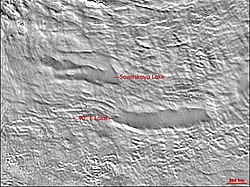Subglacial lake
A subglacial lake is a lake under a glacier . In contrast to a lake that is simply frozen, a subglacial lake is located under a permanent layer of ice that is usually several hundred or thousand meters thick. As an ecosystem, it can contain simple life forms such as bacteria .
There are a large number of subglacial lakes in Antarctica . By far the largest known subglacial lake on earth is the Vostok Lake . It has more than 112 times the volume of Lake Constance and is almost 30 times as large in area.
Characteristics
Two phenomena are responsible for the existence of subglacial lakes. On the one hand, the melting point of water ice drops under pressure. Under a layer of ice many hundreds or thousands of meters thick, the pressure increases with increasing depth so that the melting point of the ice - also referred to as the pressure melting point - drops to several degrees Celsius below 0 ° C. At the same time, the temperature in the depth increases due to geothermal energy . If the temperature is higher than the melting point from a certain depth, the ice liquefies into water.
Examples
To date, more than 370 subglacial lakes have been found under the Antarctic Ice Sheet using ice-penetrating radar and satellite images. The largest and most famous of these, Lake Vostok , is about 250 km long, 50 km wide, has a water depth of up to 1200 m and lies in total darkness at a depth of 3700 to 4100 meters under the ice. It has a temperature of around −3 ° C and is under a pressure of around 35 MPa (around 350 bar). It is believed that the subglacial lakes of Antarctica are interconnected by a network of subglacial rivers and that pressure equalization and water transport take place between them.
In 2013, a lake was drilled under the Antarctic ice sheet for the first time: microorganisms were found in Lake Whillans . In the meantime (April 2020) the Antarctic subglacial Mercer Lake was also sampled, and a surprisingly complex ecosystem was found under the approximately 1 km thick layer of ice - similar to groundwater . At least two million years ago, the sea level was so high here that the water reached into this region.
There are many subglacial volcanoes in Iceland , i.e. volcanoes covered by glaciers . Due to geothermal energy, some of them, such as Grímsvötn , have subglacial lakes. However, due to the higher geothermal energy and volcanic activities, these lakes are often not in a stable equilibrium, but instead melt the glacier regularly or irregularly and then pour out in the form of tidal waves, which are known as the glacier run .
The area of the Baltic Sea (today forming a water surface of 412,500 km 2 ) formed a huge subglacial lake in northern Europe during the cold maximum of the last glacial period , whose outlet at the beginning of the Holocene significantly shaped the Øresund Strait.
Hydrogeological consequences
During the cold phases of the Pleistocene , large masses of water were not only bound in glaciers and ice reservoirs , but also in subglacial lakes. Their volume during the last ice age cold maximum is estimated to be over 1000 km 3 . Their drainage due to global warming at the beginning of the Holocene had hydrogeological consequences. Mega floods were presumably also responsible for changes in global ocean currents and thus exerted far-reaching climatic influences, similar to the Miocene .
Microbiological relic spaces
Should Antarctic subglacial lakes such as the Vostok Sea actually contain microbial life, as is suspected, they will be interesting for research as unique ecosystems with extreme living conditions and isolated from the rest of the world for hundreds of thousands of years. In their research, great attention is paid to the risk of contamination , for example by using special drilling techniques and developing special robotic probes, so-called cryobots .
Models of extraterrestrial spaces
The subglacial lakes are also important for space research, as they are similar to the assumed conditions on celestial bodies such as Jupiter's moon Europa or Saturn's moon Enceladus , whose oceans are considered to be potential habitats for extraterrestrial life .
See also
Individual evidence
- ↑ Bethan Davies: Subglacial Lakes
- ↑ Lake in Antarctica - Frozen but complex. Accessed April 8, 2020 (German).
- ↑ Björn Hillmann: Sea level fluctuations from the Ice Age to the future Geographical Institute of the University of Kiel; Summer semester 2004; On: ikzm-d.de (PDF; German; 209 KB)
- ^ Svante Björck: A review of the history of the Baltic Sea, 13.0-8.0 ka BP. In: Quaternary International 27, 1995, pp. 19-40, doi : 10.1016 / 1040-6182 (94) 00057-C .
- ↑ Stephen J. Livingstone, Chris D. Clark, Lev Tarasov: Modeling North American palaeo-subglacial lakes and their meltwater drainage pathways. In: Earth and Planetary Science Letters , 375, August 1, 2013, pp. 13-33, doi : 10.1016 / j.epsl.2013.04.017 .
- ^ TA Jordan, F. Ferraccioli, H. Corr, A. Graham, E. Armadillo, E. Bozzo: Hypothesis for mega ‐ outburst flooding from a palaeo ‐ subglacial lake beneath the East Antarctic Ice Sheet. In: Terra Nova 22, No. 4, 2010, pp. 283-289, doi : 10.1111 / j.1365-3121.2010.00944.x .

